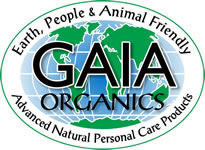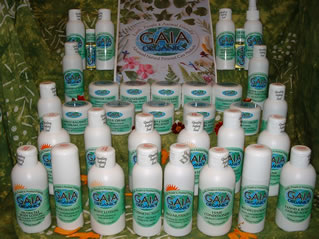|
|
 |
|
|
|
|
| THE FOLLOWING SCHEDULE REFLECTS OUR MARCH 2009 - 2010 CATALOGUE AND PRICES, WITH THE SEQUENCE FOLLOWING THE ORDER OF PLACEMENT IN THE GAIA ORGANICS DISPENSING CABINET |
|
||
Prod No. |
Product Name |
Volume |
| 01 |
Cleansing
Wash - pH-Balanced - (All Skin Types) |
100ml |
02 |
Cosmetic
Soap - Spot-Prone & Normal Skin |
100ml |
| 03 |
Moisturising
Cream Cleanser - Mature & Dry Skin |
100ml |
| 04 |
100ml |
|
| 05 |
100ml |
|
| 06 |
Alpha-Hydroxy
Fruit Acid Toner -
Mature Skin |
100ml |
| 07 |
100ml |
|
| 08 |
100ml |
|
| To
advance to the information on these products click here |
||
|
||
Prod No. |
Product Name |
Volume |
| 09 |
Day
Defense Cream: Light Moisturiser |
50ml |
10 |
Cell
Regeneration Cream: Rich Moisturiser |
50ml |
| 11 |
50ml |
|
| 12 |
50ml |
|
| 13 |
50ml |
|
| 14 |
Cell
Oil: Ultra-Fine Tissue Oil/Eye-Zone (Roll-On) |
10ml |
To
advance to the information on these products click here |
||
|
||
Prod No. |
Product Name |
Volume |
| 15 |
50ml |
|
16 |
Exzit
Spot Cream: Skin-Clearing Concealer |
50ml |
| 17 |
50ml |
|
| 18 |
50ml |
|
| 19 |
40g |
|
| 20 |
Lip
Oil: Coconut & Mint (Roll-On) |
10ml |
To
advance to the information on these products click here |
||
|
||
Prod No. |
Product Name |
Volume |
| 21 |
Extreme
UV-Sun-Defense Lotion: Immediate Defense |
150ml |
22 |
Nutricell
Body Lotion: Progressive Defense |
150ml |
| 23 |
Sunburn
Body Lotion: Soothing & Healing Accelerative |
150ml |
| 24 |
150ml |
|
| 25 |
100ml |
|
| 26 |
100ml |
|
| 27 |
100ml |
|
To
advance to the information on these products click here |
||
|
||
Prod No. |
Product Name |
Volume |
| 28 |
150ml |
|
29 |
Bio-Shampoo:
Traditional Soap Type |
150ml |
| 30 |
150ml |
|
| 31 |
150ml |
|
| 32 |
Warm
Oil Conditioner: Dry/Damaged Hair |
100ml |
| 33 |
Bio-Deodorant - Her - (Non-Antiperspirant) | 100ml |
| 34 |
100ml |
|
| 35 | Happy Nappy Baby Powder: Absorbent, Soothing, Scent-Free | 40g |
| 36 | Foot Powder | 40g |
To advance to the information on these products click here |
||
Dear Valued Consumer It is with great pleasure that we bring you our revised Gaia Organics range of natural personal care products. Scattered throughout this catalogue and more definitively dealt with in detailed reports, we will share with you the truths regarding personal care toxicology. A truly informed perspective is the key to making sense of this and using our 30-year knowledge base and full-time research facility, we are sure you will appreciate our considerable efforts to ensure your safety, including from surprisingly common natural product toxicity and health fraud. Sincerely, To read or save the full controversial 1-page Introduction, open a separate window by clicking here. |
| To read or save the full pioneering contentious 1-page statement of our superiority of our products in the local and international markets, open a separate window by clicking here |
| |
 |
|
|
To see the full article in a seperate window, please click here. |
|
 |
|
See our detailed report: “Mineral vs. Plant Oil As Carrier/Spreading Agents In Cosmetics: A Modern Reappraisal”. |
|
 |
|
|
Regular UEA contains too much Sodium lauryl sulphate, not only
as a formulating emulsifier, also more to increase utility as a
soap-free cleansing emulsion cream. It is also generally inappropriately
preserved for leave-on purposes, traditionally with chlorocresol,
but now more frequently with phenoxyethanol, which latter has spoilt
a long and impressive widespread-use history of suitability for
even troubled skin conditions such as eczema and (radiation) burns.
We stand by our UEA as superior to ‘natural’ water &
plant oil emulsions in terms of quality, safety and efficacy for
our purpose of a stable inert spreading cream for our biological
actives in such products. See
Why is Gaia Aqueous Cream safe? We again challenge the opposition
to provide a full listing of their ingredients and sub-ingredients
as we have done. We really are proud of ours, they apparently not
of theirs, as witnessed by only partial, and or vague listings of
selected hype ingredients. |
|
 |
|
| Contrary
to popular misbelief, parabens are not diabolical chemical poisons
invented by mad scientists to inflict havoc on human health.
Like us, they and their loved ones too are exposed. Parabens
have direct correlates in nature. In fact, all plants produce p-hydroxybenzoic
acid, albeit in small quantities (Viitanen
P et al, Plant Physiol, 136(4), 2004). Well-known plants
known to significantly synthesise parabens as defensive chemicals
against attack by micro-organisms include carrot, olive,
cucumber, honeysuckle and ylang ylang (Bach
M et al, Plant Physiol, 103(2), 1993); (Aziz N et al, Microbios
93(374), 1998); Smith-Becker J et al, Plant Physiol, 116(1), 1998);
(Dweck A, “Natural Preservatives”, Cosmet Toilet, Aug
2003). |
|
|
||
| |
||
 |
||
| “Most
Sunscreens Do Only Half The Job, Blocking Unsafe UV-B Rays, But
Not Skin-Damaging UV-A “With growing certainty and trepidation, dermatologists, cancer doctors and anti-aging gurus over the past decade have come to realize that available sunscreens may fight only half the battle, fending off the sun’s short-wave UV-B radiation. What’s missing is an equally useful weapon against longer-wave UV-A rays, whose deleterious effects have only recently come to light.” (Gaia Research has been saying this in the prior decade!) “Scientists have come to understand that while UV-A damage isn’t immediately visible. UV-A is now thought to be a prime culprit in premature wrinkling. More unsettling, UV-A now is believed to alter skin cell's DNA, causing mutations that can lead to the big ‘C’ (cancer).” (Gaia Research has been saying this in the prior decade!) “(Only) Avobenzone (a drug), Titanium dioxide and Zinc oxide (two natural minerals) are known to protect against UV-A (& UV-B). An application for the human drug product Mexoryl (irresponsibly already in use outside the USA and available on eBay, for example) is currently undergoing regulatory review before the FDA for permission to market or use commercially.” (Gaia use safe [non-nano-particle] Zinc oxide & Titanium dioxide) Below follows how I put the above-summarised ‘revelations’ in considerable scientific detail some 10 years ago. As I have said before. “We Lead; Others Follow”. “In Us You Can Trust. Science Fact, Not Science Fiction”. |
||
| Not only are these products bogus science and easy revenue hype for various collaborating industries, but also perpetuation of same by actively contributing to photo-ageing and even more atrociously, increasing the risk of the deeper and far more deadly skin cancers, as well as suppressing other essential factors reliant on natural sun exposure for optimum health and prevention of not only skin cancer, but also eg. menopausal complications, both high blood cholesterol and blood pressure, vitamin D deficiency, osteoporosis and even cancers other than that of the skin, especially prostate cancer and breast cancer, the fastest growing cancer epidemics amongst males and females respectively. Increasing chemical sunscreen use is scientifically linked not only to greater risk of chemical carcinogenesis (chemically induced cancer - higher SPF’s = more chemical ingredients = increased likelihood of carcinogenicity), but also enables prolonged exposure as a multiple of the Sun Protection Factor (SPF), thereby artificially delaying the natural inflammatory erythematous (reddening) warning signals which would otherwise alert one to the fact that one’s evolutionary and or ethnic tolerance level for the entire spectrum of solar exposure was being exceeded (Journal of the National Cancer Institute, Jan. 1994). Sunburn protection does not imply skin cancer protection. To access (in a separate window) the full one page
“Shocking Truth” document, replete with
verifying scientific references, click
here. |
| Gaia uses the only two natural UV-A sunscreens approved by the US FDA, namely Zinc Oxide and Titanium dioxide (Gaia do ‘not’ utilise nano-particles). Gaia also use nutritional Para-amino benzoic acid (PABA), a FDA approved natural UV-B sunscreen. Industry-wide use of synthetic PABA esters have created reputations as skin sensitisers, yet nutritional PABA, a natural component of folic acid and a B-complex vitamin constituent of many whole-foods, when stabilised with anti-oxidants such as green tea extracts, remains the safest UV-B screen available besides the refractive minerals, but unlike these, actually bonds to the skin’s surface proteins, affording durable UV-B absorptive protection should the minerals be rubbed off. Gaia also uses minimal anti-oxidant vitamin E, which is synergistic with PABA. Gaia also uses Sesame oil for its anti-oxidative lignan and phenolic constituents and for its relatively high refractive index. Tannic acid is also used in some (darker) products as an effective UV-absorber, polyphenolic anti-oxidant. Both sesamol and tannic acid have specific skin carcinoma-inhibiting properties, as does also Green tea, to an even greater degree than the former two and over and above the latter’s anti-oxidant properties, so much so that green tea extracts have been the most promising substances in the field of skin-cancer prevention and treatment for the past decade, limited only by it’s non-patentability. To access (in a separate window) the full one page
“Safe and Effective Sun Protection” document,
replete with verifying scientific references, click
here. |
| |
||
|
||
| |
||
|
Gaia is copyright © 2006 Gaia all rights
reserved Designed by Webs The Way |
||
|
Page Counter as of January 2008 |


